Flowers are versatile and come in every color of the rainbow, but some are particularly bizarre. Tucked away in obscure corners of the globe, these plants aren’t likely to show up in your landscapes anytime soon.Just to show you just how crazy various flora can look, here are some of the weirdest flowers we could find
1. Angel-Orchid:
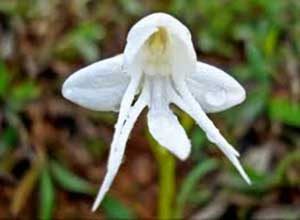
It was first discovered in 1932 and is native to the grasslands of India. The Angel Orchid is a rather short orchid in stature, topping out at just 5 inches high, with a single heart-shaped leaf that sits flat on the ground. The flowers themselves bloom in clusters ranging from one single orchid flower to five.
2. Bat-plant
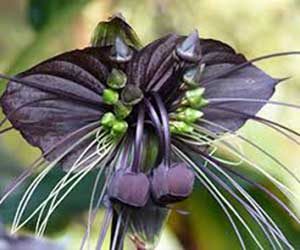
The White Bat Plant is one of the world’s largest and most unusual flowers. It’s strange little black flowers come in clusters of twenty to forty and resemble bats’ faces, while the white bracts above resemble bats’ ears. The Bat Plant can grow to anywhere between 60 and 90 centimeters tall and comes in both a black version and a white version.
3. Beehive-Ginger
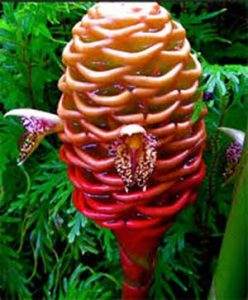
Beehive Gingers may look like they belong to the pine cone family but they are actually related to the ginger plant. Their little “cups” or “honeycombs” (actually called bracts) will collect water and give off the fragrance of ginger.
These flowers can be cultivated indoors but require lots of room and a large pot— some growing to the height of 6 feet. The flowers are tiny and white, sometimes resembling little honeybees, and they appear between the bracts.
4. Bee Orchid
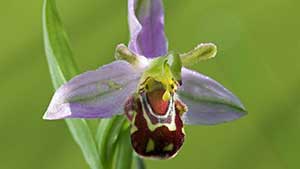
Its name comes from the Greek word “Ophrys” meaning eyebrow, perhaps referring to the fuzzy bits around the edge of the flower.
The Bee Orchid is widespread across Europe the Middle East and even North Africa, however, it’s becoming more and more scarce because the propagation process is so difficult.
This orchid is more clever than it appears the flowers are almost exclusively self-pollinating in the northern ranges.
5. Birds of Paradise
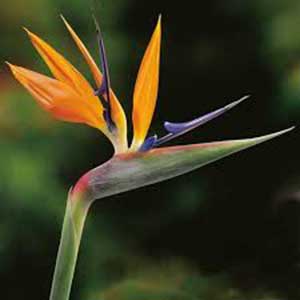
The Birds of Paradise flower is one of the most popular and widely-recognized tropical flower in the world. It’s aptly named for its resemblance to a Bird of Paradise taking flight.
The Bird of Paradise can be cultivated outdoors in tropical, warm climates, as well as indoors for those residing in colder temperatures.
Despite its intricate beauty, the Bird of Paradise flower is actually quite easy to grow and care for, requiring little maintenance other than light, warmth, and water when needed.
6. Brazilian Dutchman’s Pipe

This Brazilian native vaguely resembles the Sherlock-style pipe that was popular in Holland, despite being located halfway around the globe. Also known as the Giant Pelican Plant, the flower gives off a foul odor despite its spectacular appearance.
But that’s not the only thing that makes the Giant Dutchman’s Pipe less than appealing. The plant is classified as a danger to the Pipevine Swallowtail butterfly, which confuses the Dutchman’s Pipe with its native host plant.
7. Corpse Flower
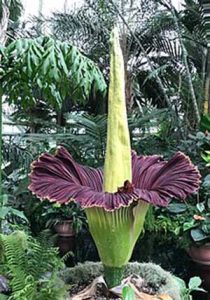
The Corpse Flower of which we speak now is much rarer and can only be found in the rainforests of Indonesia. The Corpse Flower is a parasitic organism that has no visible leaves, roots or stems, causing some to argue that the Corpse Flower isn’t a flower at all rather a fungus. In addition to its vampiric traits, the Corpse Flower is the world’s largest individual flower.
8. Corpse Lily
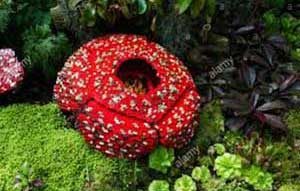
The largest flower in the world, Rafflesia arnoldii, is actually a parasite. The corpse lily, as it’s commonly known, expends all of its energy working through the vine to produce a 3-foot (1-meter) diameter bloom and thousands of seeds.
A single flower can weigh up to up to 25 pounds (11 kilograms) and hold several gallons (liters) of nectar in a central cavern surrounded by five petals.
9. Dancing Girls
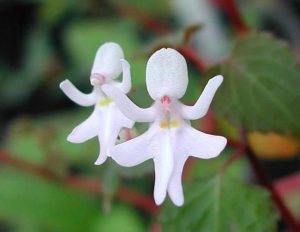
These little beauties are one of the rarest flowers around and prove quite hard to find even for the most determined plant collector. Nicknamed for their resemblance to dancing ladies in dresses, these tiny flowers are native to East Africa and come in white and light pink.
The plant itself is quite petite, growing to just about one foot across and bearing blooms that max out at ½” long. Dancing Girls will root wherever they touch the soil and they make excellent indoor plants if you can find one.
10. Darth Vader
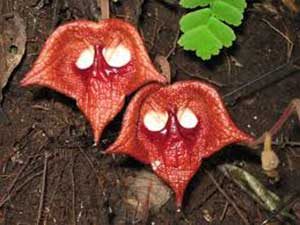
Darth Vader plant a woody climber native to the humid meadows and soggy flood plains of Brazil, belongs to the Aristolochiaceae family of plants. The helmet-like shape and purple coloration of the blooms, combined with the powerful aroma of rotting flesh, tends to attract insect pollinators.
The inside of the blooms is lined with sticky hairs that imprison the unfortunate guests long enough to cover them with pollen. They are then released to fly out and pollinate more blooms. Each bloom lasts only a single week.
11. Desert Pea

This weird, wonderful flower is quite the evolutionary produce, surviving and thriving in dry, arid climates. The blood-red petals with their bulbous, purplish-black middles make these flowers look more like aliens.
Perhaps that’s why the Desert Pea is one of Australia’s best-known and most recognized wildflowers. But just because it happens to be one of the most famous wildflowers in Australia doesn’t mean you can go around and start picking it; quite the opposite in fact. The Desert Pea is a protected species, and it is illegal to collect.
12. Devils Hand
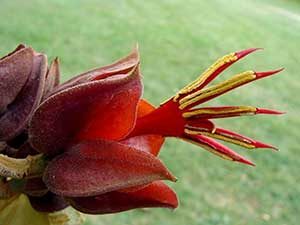
The Devil’s Hand is native to Mexico where the Ancient Aztecs held it in extraordinarily high religious regard, who harvested the claw-like flowers for generations and generations.
The fruit produced by this tree has an earthy taste and has been used for years in traditional medicine to treat heart disease and heart conditions. Unlike some tropical plants, the Devil’s Hand tree is extremely hardy and can grow relatively fast, reaching upwards of 40’ to 90’ tall.
13. Dove Orchid
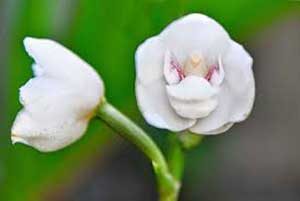
The Dove or Holy Ghost Orchid produces delicately marbled white flowers that, if you look closely, look like they have a small dove with open wings perched inside.
While most orchids can be found growing on or near trees, this type of orchid differentiates itself by growing on ground level, sometimes on rocks. The dove inside the flower is so intricate it looks almost like it’s been carved out of ivory.
It is nicknamed the Holy Ghost Orchid because, in the Bible, the Holy Ghost took the form of a dove. This type of orchid is so highly-sought and over-picked that it is classified as endangered in its native country.
14. Flame Lily

This perennial plant is both a climber and scrambler and adds intrigue wherever it grows. The Flame Lily thrives in many parts of the world and is widely propagated as a prized ornamental addition to flower gardens.
Like nearly all lilies, the Flame Lily is considered poisonous to humans and animals (especially cats!), so if you insist on growing it make sure to take proper precautions.
A fun fact about the Flame Lily is that it’s actually considered a weed that thrives naturally in sandy coastal conditions. That’s one weed we wouldn’t mind having in our backyard.
15. Flying Duck Orchid
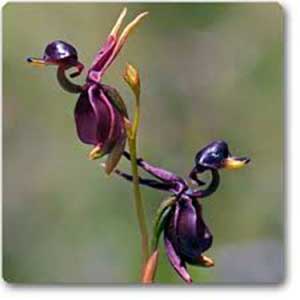
This fowl orchid is just too cute. flying duck orchid plants (Caleana major) are amazing orchids that produce you guessed it distinctive duck-like blooms.
The red, purple and green blooms, which appear in late spring and early summer, are tiny, measuring only ½ to ¾ inches in length. Here are a few more interesting facts about flying duck orchids.
16. Fly Orchid

The Fly Orchid is a relatively widespread type of European orchid that grows between 11 and 15 inches tall. Flowers that look like little flies, with big, black, bug eyes and all. But that’s not where this orchid gets its name from.
The Fly Orchid is named such because it was discovered that it attracts flies and aphids. In fact, its tuber can be dried and turned into Salep, which is said to be very nutritious. However, we take no responsibility for any ill effects caused by eating your Orchids.
17. Hammer Orchid

The Hammer Orchid also nicknames the King-in-His-Carriage. This teeny little flower is easy to miss, but if you’re lucky enough to find it, you’ll likely never forget it.
The design of the Hammer Orchid (named for its ability to reset itself) is intended on luring wasps for pollination. In fact, the flower secretes a pheromone that mimics that of the female wasp, which lures unsuspecting males to land on its dark purple labellum.
18. Happy Alien

Some call it Darwin’s Slipper, other the Happy Alien, and still more call them Chamber Maids. But no matter what name they go by, these crazy little mountain flowers are truly one of a kind.
Originally discovered by Darwin between 1831 and 1836, the Chamber Maids love cold weather and can still be found in profusion in Tierra del Fuego, South America. They only grow to be about 4 inches tall with blooms of just 2 inches long.
19. Hooker’s Lips

Hooker Lips, Hot Lips, Flower Lips— call them what you will— there’s no guessing how this plant got its name. The bright red bits that resemble a hooker’s bright red lips are bracts, not petals.
The leaf-like bracts are only in their kissable state for a few days before opening to reveal the little yellow and white flowers within. The Hooker’s Lips Plant is native to the tropical regions of Colombia, Costa Rica, and Panama.
20. Laughing Bumble Bee Orchid
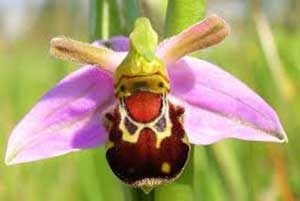
This happy little guy gets its name from its uncanny resemblance to a smiling bumblebee; that is if bumblebees could smile. Its name comes from the Greek word “Ophrys” meaning eyebrow, perhaps referring to the fuzzy bits around the edge of the flower.
The Bee Orchid is widespread across Europe the Middle East and even North Africa. However, it’s becoming more and more scarce because the propagation process is so complicated.
21. Lithops Weberi
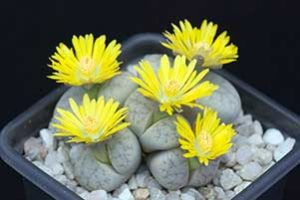
Lithops Weberi, otherwise known as Living Stones. These awesome little succulents are perfect to grow indoors, especially for folks whose thumbs are not so green.
These little wonders are native only to South Africa, where their evolutionary progress turned them into a drought-proof plant. When Lithops bloom, it looks extraordinary, with a white or yellow daisy poking out from what appears to be solid stone.
22. Lobster Claw
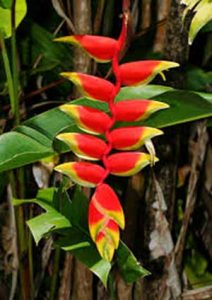
Lobster Claw also known as the False Bird of Paradise and Wild Plantain, the Lobster Claw’s cheerful flowers emerge from clumps of leaves that look like bananas. The reddish flower-like bracts actually hide the plant’s true flowers, which require birds with specialized beaks for pollination.
An excellent landscape plant, the Lobster Claw can grow up to a height of 3.5’ tall and they bloom several times each year. Be sure to provide your Lobster Claws with plenty of water and fertilizer to maximize your blooms.

